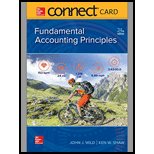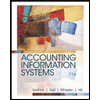
Concept explainers
Problem 1-1B Identifying effects of transactions on financial statements A1 P1
Identify how each of the following separate transactions 1 through 10 affects financial statements. For increases, place a “+” and the dollar amount in the column or columns. For decreases, place a "-" and the dollar amount in the column or columns. Some cells may contain both an increase (+) and a decrease (-) along with dollar amounts. The first transaction is completed as an example.
Required
a. For the
b. For the statement of
| a. | b. | |
| Income | ||
| Balance Sheet | Statement | Statement of Cash Flows |
| Transaction | TotalAssets | Total Liab. | Total Equity | NetIncome | Operating Activities | Investing Activities | Financing Activities | |
| 1 | Owner invests $800 cash in business | +800 | +800 | +800 | ||||
| 2 | Purchases $100 of supplies on credit | |||||||
| 3 | Buys equipment for $400 cash | |||||||
| 4 | Provides services for $900 cash | |||||||
| 5 | Pays $400 cash for rent incurred | |||||||
| 6 | Buys $200 of equipment or credit | |||||||
| 7 | Pays $300 cash for wages incurred | |||||||
| 8 | Owner withdraws $50 cash | |||||||
| Provides $600 services on credit | ||||||||
| 10 | Collects $600 cash on |
Want to see the full answer?
Check out a sample textbook solution
Chapter 1 Solutions
Connect Access Card For Fundamental Accounting Principles
- Which account would be closed at year-end?A. EquipmentB. Utilities ExpenseC. Retained EarningsD. Accounts Payablearrow_forwardCan you explain the correct approach to solve this general accounting question?arrow_forwardI am looking for the correct answer to this financial accounting problem using valid accounting standards.arrow_forward
- The accounting equation must always remain balanced. If an asset increases, what must happen?A. A liability must decreaseB. An equity account must decreaseC. Another asset must decrease, or liability/equity must increaseD. Revenue must decreasearrow_forwardA ledger is:A. A book containing all journal entriesB. A financial reportC. A group of accountsD. A summary of cash inflows i need helparrow_forwardA ledger is:A. A book containing all journal entriesB. A financial reportC. A group of accountsD. A summary of cash inflowsno aiarrow_forward
- A ledger is:A. A book containing all journal entriesB. A financial reportC. A group of accountsD. A summary of cash inflowsarrow_forwardI need help solving this financial accounting question with the proper methodology.arrow_forward18. Inventory shrinkage is recorded as:A. Increase in revenueB. Decrease in liabilitiesC. Inventory loss expenseD. Owner withdrawalarrow_forward
- 19. What does a classified balance sheet show?A. Net cash from operationsB. Revenue by categoryC. Assets and liabilities in current and long-term sectionsD. Owners' drawings helparrow_forwardI am trying to find the accurate solution to this financial accounting problem with the correct explanation.arrow_forward19. What does a classified balance sheet show?A. Net cash from operationsB. Revenue by categoryC. Assets and liabilities in current and long-term sectionsD. Owners' drawingsarrow_forward
- Principles of Accounting Volume 1AccountingISBN:9781947172685Author:OpenStaxPublisher:OpenStax College
 Financial Accounting: The Impact on Decision Make...AccountingISBN:9781305654174Author:Gary A. Porter, Curtis L. NortonPublisher:Cengage Learning
Financial Accounting: The Impact on Decision Make...AccountingISBN:9781305654174Author:Gary A. Porter, Curtis L. NortonPublisher:Cengage Learning Financial Reporting, Financial Statement Analysis...FinanceISBN:9781285190907Author:James M. Wahlen, Stephen P. Baginski, Mark BradshawPublisher:Cengage Learning
Financial Reporting, Financial Statement Analysis...FinanceISBN:9781285190907Author:James M. Wahlen, Stephen P. Baginski, Mark BradshawPublisher:Cengage Learning  Cornerstones of Financial AccountingAccountingISBN:9781337690881Author:Jay Rich, Jeff JonesPublisher:Cengage Learning
Cornerstones of Financial AccountingAccountingISBN:9781337690881Author:Jay Rich, Jeff JonesPublisher:Cengage Learning Accounting Information SystemsFinanceISBN:9781337552127Author:Ulric J. Gelinas, Richard B. Dull, Patrick Wheeler, Mary Callahan HillPublisher:Cengage Learning
Accounting Information SystemsFinanceISBN:9781337552127Author:Ulric J. Gelinas, Richard B. Dull, Patrick Wheeler, Mary Callahan HillPublisher:Cengage Learning Intermediate Accounting: Reporting And AnalysisAccountingISBN:9781337788281Author:James M. Wahlen, Jefferson P. Jones, Donald PagachPublisher:Cengage Learning
Intermediate Accounting: Reporting And AnalysisAccountingISBN:9781337788281Author:James M. Wahlen, Jefferson P. Jones, Donald PagachPublisher:Cengage Learning





